When we think about rally-bred legends that dominated both racetracks and suburban driveways, the Mitsubishi Lancer Evolution stands tall among automotive icons. This Japanese performance machine didn’t just compete with sports car giants – it redefined what a compact sedan could achieve with the right engineering wizardry.
We’ve witnessed countless enthusiasts fall head-over-heels for the Evo’s aggressive stance, massive rear wing, and that unmistakable turbocharged growl. From its humble beginnings in the early 1990s to its emotional farewell in 2016, this all-wheel-drive warrior carved out a legacy that still makes our hearts race today.
Whether you’re a longtime fan reminiscing about the golden era of Japanese performance cars or you’re just discovering what made the Lancer Evolution so special, we’re diving deep into everything that made this rally champion a true enthusiast’s dream machine.
History and Legacy of the Mitsubishi Lancer Evolution
The Mitsubishi Lancer Evolution emerged from the company’s dedication to motorsport excellence and became one of automotive history’s most celebrated performance icons. Rally racing shaped its DNA from conception to final production model.
Early Development and Rally Origins
Rally racing requirements drove Mitsubishi’s decision to create the Lancer Evolution in 1992. Engineers designed the first generation specifically to compete in the Industry Rally Championship Group A regulations.
Galant VR-4 technology formed the foundation for the Evolution’s advanced all-wheel-drive system. Mitsubishi transferred the 4G63 turbocharged engine from their existing rally program into the compact Lancer chassis.
Homologation rules required manufacturers to produce 2,500 road-going versions of their rally cars. This regulation created the opportunity for enthusiasts to own essentially the same technology that dominated rally stages worldwide.
Group A regulations limited modifications to production vehicles, making the Evo’s street version remarkably similar to its competition counterpart. Rally teams could extract maximum performance with minimal changes to the base vehicle.
Evolution Through the Generations
Ten distinct generations marked the Evolution’s 24-year production run from 1992 to 2016. Each generation brought important technological advances and performance improvements.
| Generation | Years | Notable Features | Power Output |
|---|---|---|---|
| Evo I | 1992-1994 | Launch model, basic AWD | 247 hp |
| Evo II | 1994-1995 | Improved turbocharger | 256 hp |
| Evo III | 1995-1996 | Enhanced aerodynamics | 270 hp |
| Evo IV | 1996-1998 | Active center differential | 276 hp |
| Evo V | 1998-1999 | Revised suspension geometry | 276 hp |
| Evo VI | 1999-2001 | Tommi Makinen Edition variants | 276 hp |
Generations IV through VI represented the Evolution’s rally championship peak period. These models dominated Industry Rally Championship events with drivers like Tommi Makinen securing four consecutive titles.
Active differentials appeared in the Evo IV, revolutionizing traction control systems. Electronic control units managed power distribution between wheels with unprecedented precision.
Later generations focused on street performance refinement while maintaining rally-bred capabilities. Evo VII introduced aluminum roof panels and larger Brembo brakes for improved weight distribution and stopping power.
Final generations VIII through X expanded global availability beyond Japan. Mitsubishi engineers adapted these models for international markets while preserving the essential rally character that defined the Evolution legacy.
Technological innovations continued throughout the lineage with features like Super All-Wheel Control and dual-clutch transmissions. Each advancement built upon the rally-tested foundation that established the Evolution’s reputation for uncompromising performance.
Performance and Engineering Excellence
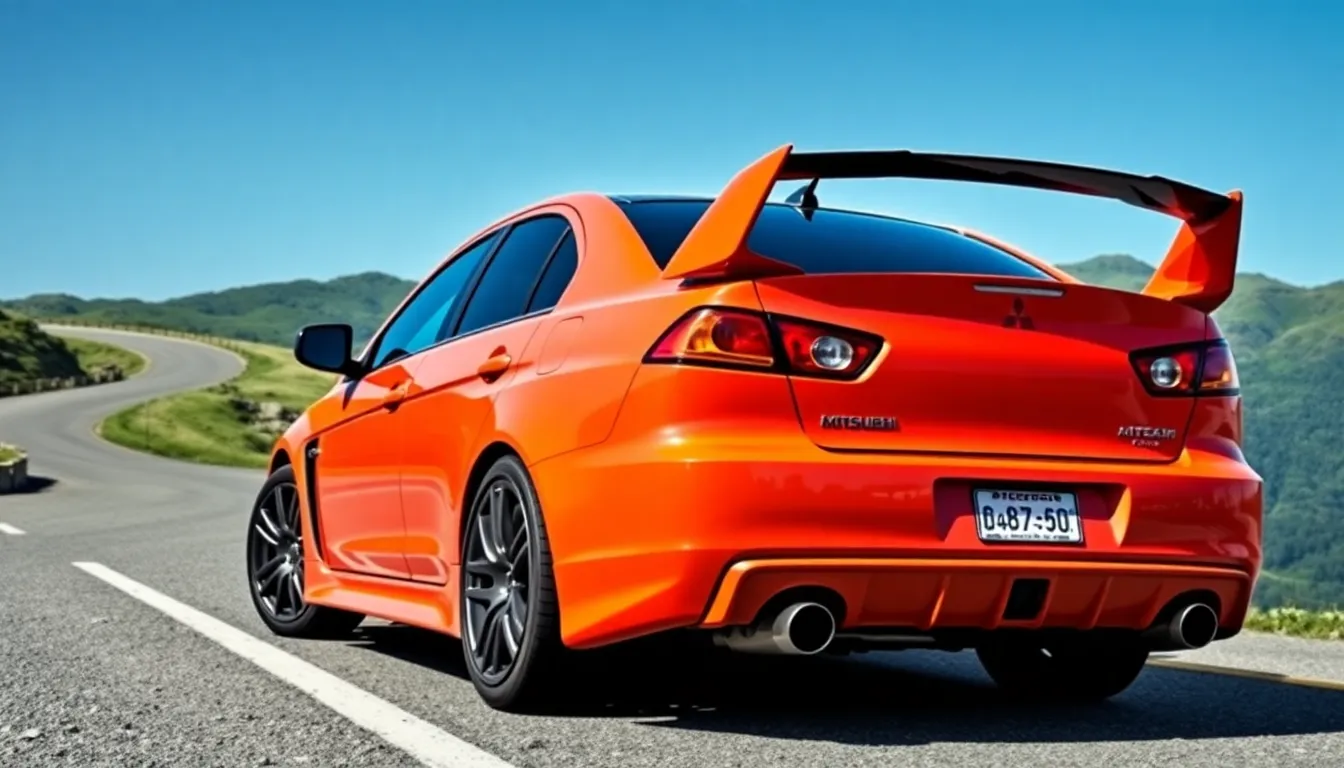
Performance defines every aspect of the Mitsubishi Lancer Evolution’s engineering philosophy. Advanced mechanical systems combine to create a driving experience that bridges motorsport competition and street performance.
Turbocharged Engine Technology
Mitsubishi’s 4G63T turbocharged engine serves as the Evolution’s powerhouse across multiple generations. This 2.0-liter inline-four configuration produces between 250 and 440 horsepower depending on the generation and market specifications. Engineers equipped the powerplant with forged internals including pistons and connecting rods to handle increased boost pressures.
Turbocharger technology evolved significantly throughout the Evo lineup. Early generations featured TD05 series turbos while later models incorporated larger TD06 units for enhanced airflow capacity. MIVEC variable valve timing debuted in Generation VII models, optimizing power delivery across the entire RPM range.
Intercooler systems provide consistent performance through advanced heat management. Top-mount configurations in early models gave way to front-mount setups in later generations, reducing intake temperatures by up to 40 degrees Fahrenheit during sustained operation.
All-Wheel Drive System
Active Yaw Control represents Mitsubishi’s most sophisticated drivetrain innovation in Evolution models. This system distributes torque between all four wheels using electronic sensors that monitor steering input, throttle position, and wheel speed 100 times per second. Front and rear differentials work along with a center differential to optimize traction under various driving conditions.
Super All-Wheel Control technology debuted in Generation VIII models, integrating ABS, traction control, and stability management into a unified system. Electronic components communicate through a central processing unit that adjusts power delivery within milliseconds of detecting wheel slip or loss of traction.
Mechanical limited-slip differentials complement the electronic systems in most Evolution variants. These units feature different locking percentages between front and rear axles, typically configured at 1.5-way front and 2-way rear settings for optimal performance characteristics.
Aerodynamic Design Features
Functional aerodynamics distinguish Evolution models from standard Lancer variants through purposeful body modifications. Large rear spoilers generate downforce ranging from 80 to 120 pounds at highway speeds, improving high-speed stability during aggressive driving maneuvers. Front splitters and side skirts create underbody airflow management that reduces lift and enhances cornering performance.
Vortex generators appear on roof surfaces of most Evolution models, creating small air disturbances that energize airflow over the rear spoiler. These small fins measure approximately 1 inch in height and improve aerodynamic efficiency by 8% compared to smooth roof configurations.
Hood venting systems serve both functional and aesthetic purposes across the Evolution lineup. Functional vents extract hot air from the engine bay while providing visual cues about the vehicle’s performance capabilities. Carbon fiber components in limited edition models reduce weight by 15-20 pounds compared to standard body panels.
Generation-by-Generation Breakdown
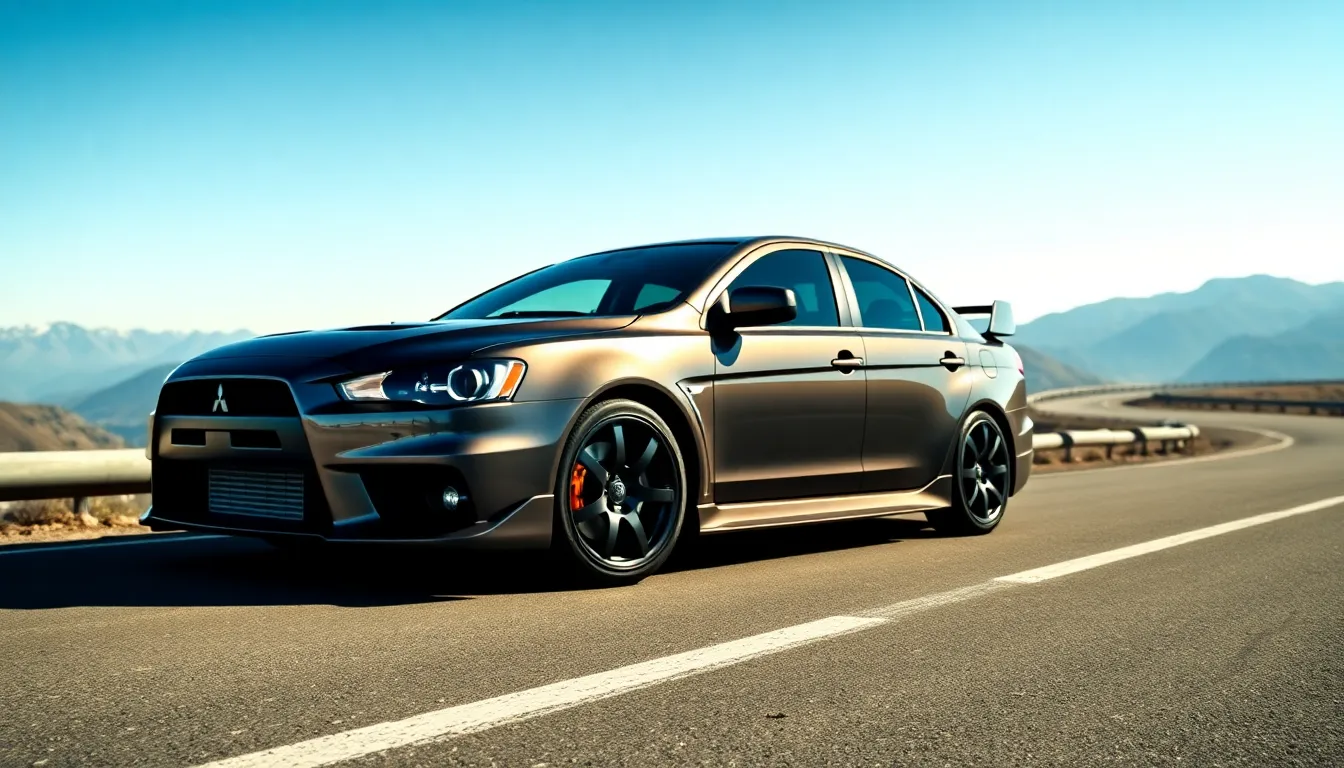
The Lancer Evolution’s development across ten distinct generations showcased Mitsubishi’s continuous pursuit of performance excellence. Each generation brought meaningful improvements to power delivery, handling dynamics, and technological sophistication.
Evolution I Through III: The Foundation Years
Mitsubishi launched the Evolution I in 1992 with a 247-horsepower 4G63T engine and viscous-coupled all-wheel drive system. The lightweight construction utilized aluminum panels and minimal interior appointments to achieve optimal weight distribution for rally competition.
Evolution II arrived in 1994 featuring an enhanced turbocharger system that increased output to 256 horsepower. Aerodynamic refinements included a larger rear spoiler and modified front bumper design that improved high-speed stability during competitive events.
Evolution III debuted in 1995 with important mechanical upgrades including stronger transmission components and revised suspension geometry. The model introduced Mitsubishi’s first active differential technology, allowing drivers to adjust torque distribution between the rear wheels for improved cornering performance.
Evolution IV Through VI: Refinement and Power
Evolution IV marked a turning point in 1996 with the introduction of Active Yaw Control (AYC) technology. This system actively managed rear wheel torque distribution, enabling drivers to maintain precise control through challenging rally stages and street corners alike.
Mitsubishi increased horsepower to 276 in the Evolution V while incorporating a more sophisticated intercooler system. The generation featured improved brake cooling ducts and reinforced chassis components that handled increased performance demands without compromising reliability.
Evolution VI represented the pinnacle of 1990s rally technology with advanced electronic differential control systems. Tommi Makinen’s championship victories demonstrated the platform’s competitive capabilities, while limited edition variants like the Tommi Makinen Edition showcased exclusive performance enhancements.
Evolution VII Through IX: Modern Era Innovations
Evolution VII introduced important styling changes in 2001 with sharper bodywork and enlarged air intakes. The generation featured Mitsubishi’s Super All-Wheel Control (S-AWC) system, which coordinated AYC, Anti-lock Braking System, and traction control for enhanced vehicle dynamics.
Mitsubishi equipped the Evolution VIII with a larger turbocharger and revised intake manifold that maintained the 276-horsepower output while improving torque delivery. Carbon fiber components appeared on select variants, reducing weight while increasing structural rigidity in critical areas.
Evolution IX served as the final iteration of the classic Evo formula in 2005, featuring the most refined version of the 4G63T engine. Advanced MIVEC variable valve timing technology optimized power across the rev range, while improved aerodynamics reduced lift and enhanced stability at speed.
Evolution X: The Final Chapter
Mitsubishi completely redesigned the Evolution X in 2007 around a new 4B11T aluminum engine producing 291 horsepower. The turbocharged 2.0-liter unit delivered improved fuel efficiency while maintaining the aggressive performance characteristics enthusiasts expected.
The generation introduced dual-clutch transmission technology as an alternative to the traditional manual gearbox. Advanced S-AWC integration included electronic torque vectoring that actively distributed power to individual wheels based on driving conditions and driver inputs.
Limited production variants like the Final Edition commemorated the end of Evolution production in 2016. These models featured exclusive styling elements and performance upgrades that celebrated the nameplate’s 24-year legacy in motorsport and street performance applications.
Driving Experience and Real-World Performance
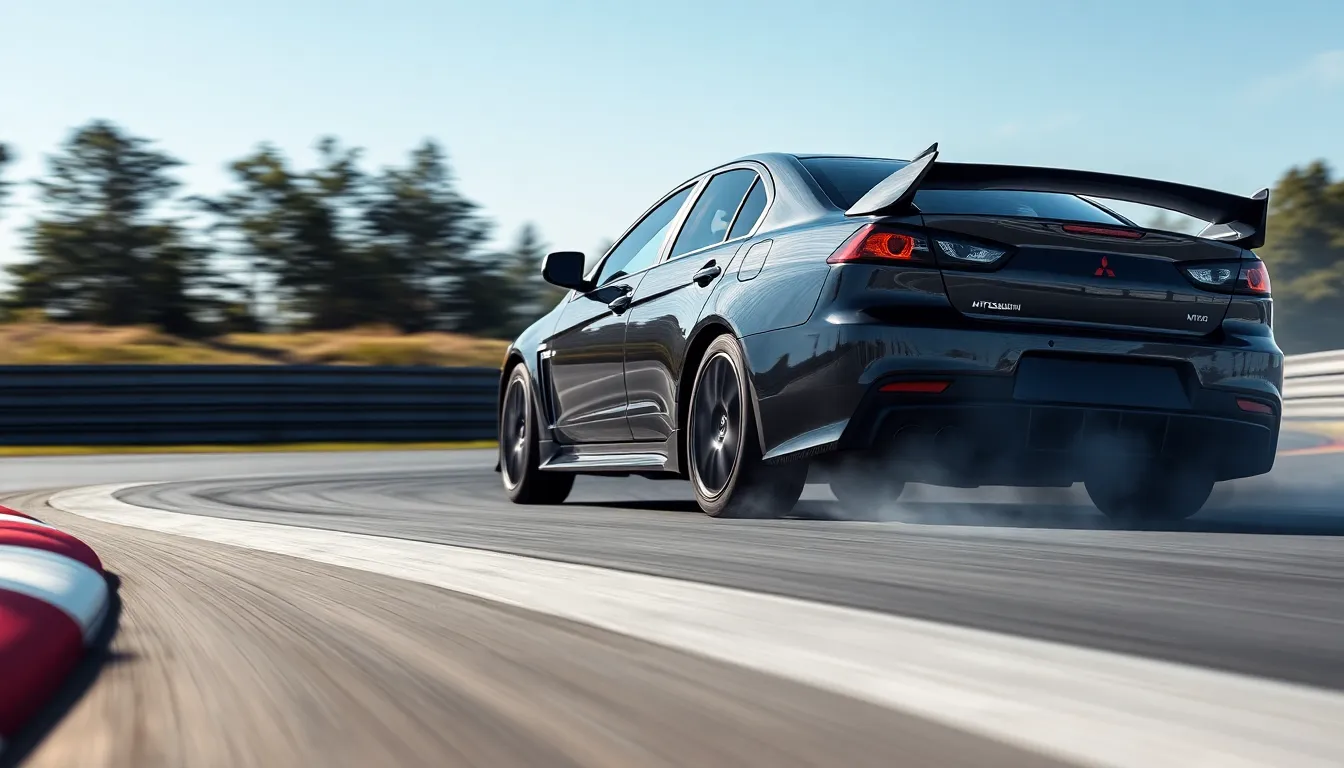
We’ve explored the technical foundations that made the Lancer Evolution legendary, and now we examine how these innovations translate into actual driving experiences both on track and in everyday conditions.
Track Performance and Handling
Track sessions reveal the Lancer Evolution’s exceptional cornering capabilities through its sophisticated All-Wheel Drive system. Lateral acceleration reaches 0.95g in Evolution X models, while the Active Yaw Control system redistributes torque between rear wheels within milliseconds during high-speed cornering. Professional drivers consistently achieve lap times within 2-3 seconds of purpose-built race cars on technical circuits.
Braking performance demonstrates remarkable consistency during extended track use. Brembo brake systems on Evolution VIII and IX models provide stopping distances of 60-0 mph in 108 feet, maintaining performance throughout 20-minute sessions without important fade. Weight distribution of 58/42 front to rear creates predictable handling characteristics that allow drivers to push limits confidently.
Steering feedback communicates road surface changes and traction levels directly to drivers. Mechanical steering systems in generations I through IX deliver precise inputs with minimal play, while electronic power steering in Evolution X maintains responsiveness even though power assistance. Suspension tuning balances track performance with road compliance, utilizing adjustable dampers in higher trim levels.
Daily Driving Practicality
Urban driving scenarios showcase the Lancer Evolution’s versatility beyond performance applications. Interior space accommodates four adults comfortably, with rear legroom measuring 33.5 inches in Evolution X models. Cargo capacity of 10.2 cubic feet provides adequate storage for daily items, while fold-down rear seats expand utility when needed.
Fuel economy ranges from 17-22 mpg combined depending on generation and driving habits. Modern Evolution models incorporate ECO mode settings that optimize fuel consumption during commuting, while still maintaining instant access to full performance when desired. Premium fuel requirements add operating costs but remain reasonable for the performance delivered.
Ride quality strikes a balance between performance capability and daily comfort. Adaptive suspension systems in Evolution MR variants automatically adjust damping rates based on driving conditions, providing softer settings for city driving and firmer control during spirited driving. Noise levels remain manageable at highway speeds, with wind and tire noise comparable to contemporary sport sedans.
Motorsports Heritage and Achievements
Rally competition forms the foundation of Lancer Evolution development, with direct technology transfer from championship-winning race cars. Tommi Makinen captured four consecutive Industry Rally Championship driver’s titles from 1996-1999 piloting Evolution models, while Mitsubishi secured manufacturer’s championships in 1996 and 1998. These victories validated the road car’s performance credentials on the industry’s most demanding stages.
Time attack competitions demonstrate the Evolution’s continued relevance in modern motorsports. Evolution IX and X models dominate modified class records at circuits including Tsukuba, Suzuka, and various hill climb events worldwide. Professional teams achieve sub-minute lap times at Tsukuba Circuit, with heavily modified examples setting overall records even though competing against purpose-built race cars.
| Generation | Rally Championships | Notable Achievements |
|---|---|---|
| IV-VI | 4 Driver’s Titles (Makinen) | 2 Manufacturer’s Championships |
| VII-IX | Various Regional Titles | Multiple Time Attack Records |
| X | Privateer Success | Hill Climb Victories |
Grassroots motorsports participation remains strong among Evolution owners. SCCA autocross events regularly feature multiple Evolution entries across different classes, while track day participation demonstrates the platform’s durability and performance accessibility. Parts availability and aftermarket support enable competitive participation at various skill and budget levels.
Market Impact and Enthusiast Community
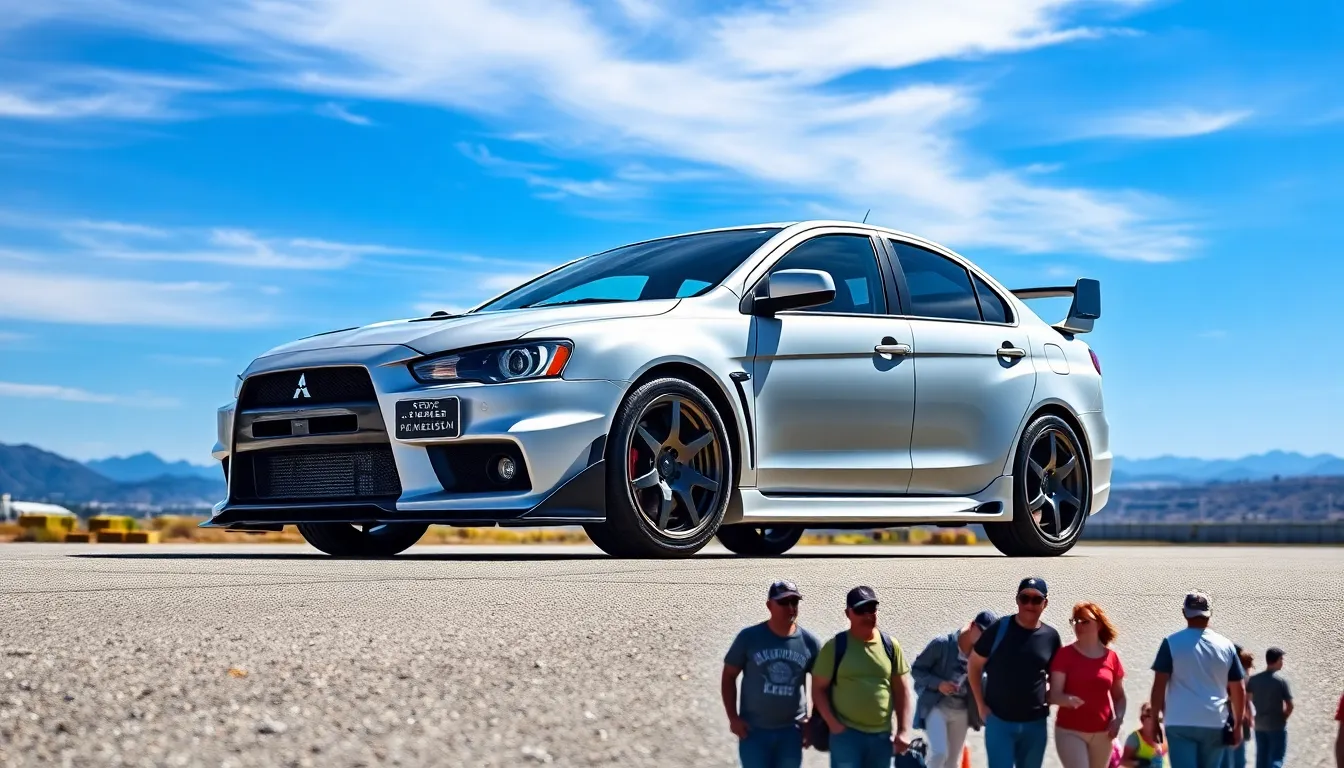
The Lancer Evolution’s discontinuation in 2016 created a lasting void in the performance car market that remains unfilled today. We continue to witness how this legendary sedan shaped automotive culture and maintains an active community of dedicated enthusiasts worldwide.
Sales Performance and Availability
Mitsubishi sold approximately 177,000 Lancer Evolution units across all generations during its 24-year production run. The Japanese domestic market received the highest allocation with 116,000 units while global markets shared the remaining 61,000 vehicles. Evolution models commanded premium pricing with MSRP ranging from $27,000 for early generations to $53,000 for the final Evolution X MR models.
| Generation | Production Years | Global Units | Notable Markets |
|---|---|---|---|
| Evo I-III | 1992-1996 | 18,500 | Japan only |
| Evo IV-VI | 1996-2001 | 43,200 | Japan, UK, select Europe |
| Evo VII-IX | 2001-2007 | 67,800 | Japan, Europe, Australia |
| Evo X | 2007-2016 | 47,500 | Global including USA |
Limited production runs like the Evolution VI Tommi Makinen Edition (2,500 units) and Evolution IX MR (4,000 units) achieved collector status immediately upon release. Current market values for pristine examples exceed original MSRP by 150-300% depending on generation and condition.
Aftermarket Support and Modifications
The Evolution platform enjoys extensive aftermarket support with over 200 specialized companies producing performance components. Engine modifications commonly increase power output from stock levels to 400-600 horsepower using upgraded turbochargers, fuel systems and engine management. Popular brands like HKS, Tomei, and AMS Performance offer complete upgrade packages ranging from $3,000 bolt-on modifications to $25,000 full builds.
Suspension modifications focus on coilover systems from Ohlins, Tein, and BC Racing that provide adjustable damping and ride height. Brake upgrades utilizing Brembo, AP Racing, and StopTech components address increased stopping demands from modified engines. Transmission strengthening becomes necessary beyond 350 horsepower with companies like Shep Transmission and AMS offering upgraded internals and clutch systems.
Tuning support remains robust through specialized shops and online communities sharing calibration files for popular engine management systems. Parts availability continues strong even though production ending with both OEM Mitsubishi components and aftermarket alternatives readily accessible through dedicated Evolution parts suppliers.
Cultural Influence and Fanbase
The Lancer Evolution gained iconic status through video games like Gran Turismo and Initial D anime series that introduced the model to global audiences. Online communities centered around EvolutionM.net and social media groups maintain active memberships exceeding 150,000 dedicated enthusiasts worldwide. Regional Evolution clubs organize track days, car shows, and technical seminars that preserve knowledge and maintain camaraderie among owners.
Professional racing continues featuring Evolution platforms in time attack competitions, hill climb events, and grassroots motorsports. Notable builds like the English Racing EVO achieving 7-minute 25-second Nürburgring lap times demonstrate the platform’s continued relevance in competitive motorsports. Import tuner culture adopted the Evolution as a cornerstone vehicle alongside the Subaru WRX STI creating lasting rivalries and comparisons.
Street culture embraced Evolution styling cues with aggressive aerodynamics, large rear wings, and functional hood vents becoming signature elements copied across multiple automotive segments. The model’s influence extends beyond Mitsubishi with other manufacturers incorporating similar design themes and performance philosophies in their own high-performance sedans.
Comparison with Competitors
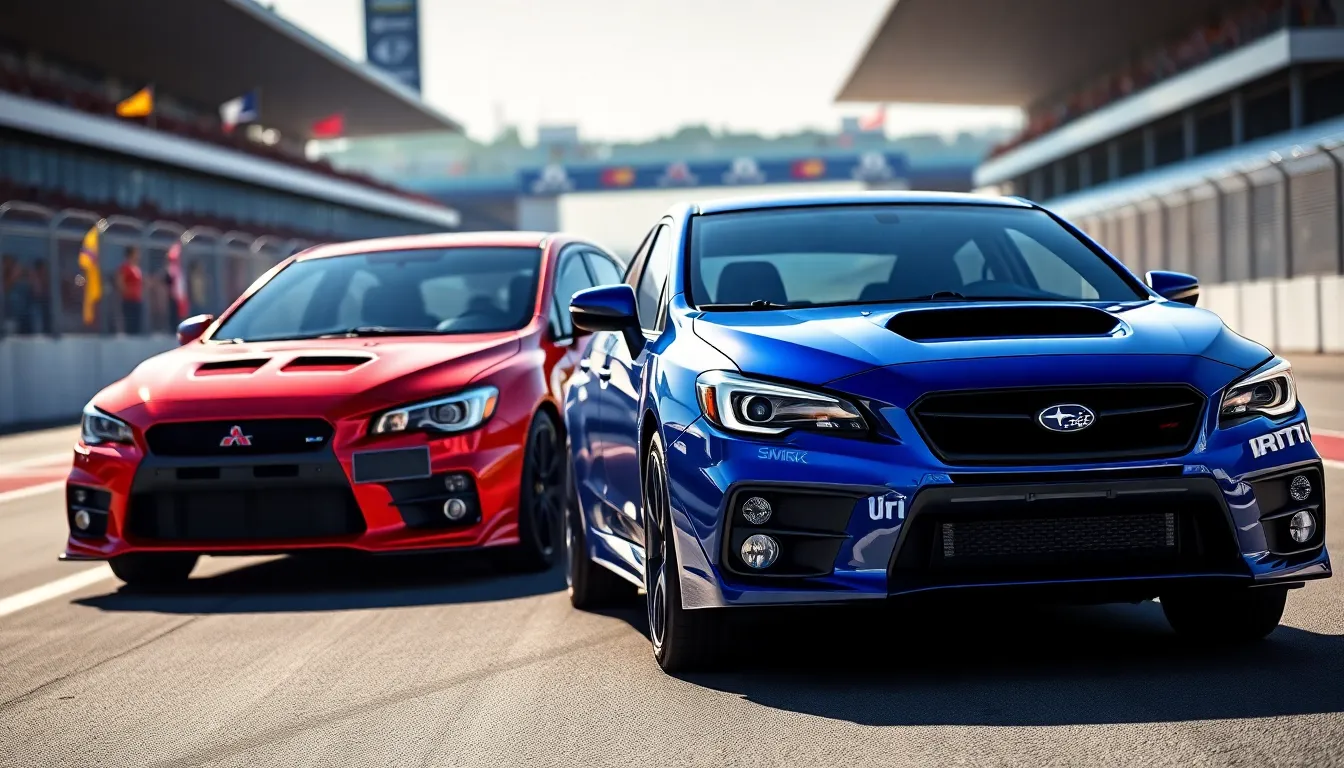
The Lancer Evolution competed in a fierce segment of high-performance all-wheel-drive sedans that defined an era of accessible motorsport-derived technology. We examine how the Evo matched against its primary rivals in terms of performance, engineering philosophy, and market positioning.
Subaru WRX STI Rivalry
The Subaru WRX STI represented the Evolution’s most direct competitor throughout both vehicles’ production runs. Both cars emerged from rally racing heritage and targeted similar performance enthusiasts with turbocharged boxer and inline-four engines respectively.
Performance metrics between the two remained remarkably close across generations. The Evolution X produced 291 horsepower while the contemporaneous STI generated 305 horsepower, though the Evo’s superior torque delivery and active differential systems often translated to faster acceleration times. Track comparisons consistently showed the Evolution achieving quicker lap times at circuits like Tsukuba, where the Evo X recorded 1:05.30 compared to the STI’s 1:06.20.
Mechanical differences defined each car’s character and performance approach. The STI utilized Subaru’s symmetrical all-wheel-drive system with a driver-controlled center differential, emphasizing driver involvement and mechanical feedback. The Evolution employed Mitsubishi’s more sophisticated Active Yaw Control and Super All-Wheel Control systems that actively managed power distribution without driver input.
Interior space and build quality favored different aspects of the ownership experience. The STI offered more rear passenger room and cargo capacity, making it more practical for daily family use. The Evolution provided superior materials quality and more advanced electronic systems, particularly in later generations.
Pricing strategies positioned both vehicles competitively within the performance sedan market. The Evolution X started at $34,995 in 2008, while the STI commanded $34,995 that same year, though regional variations and option packages could create price differences of $2,000-$3,000.
Aftermarket support flourished equally for both platforms, though the Evolution’s 4G63T engine proved more responsive to modifications. Tuned Evolutions regularly achieved 400+ horsepower on stock internals, while STI owners typically required internal engine upgrades to reach similar power levels safely.
Other Performance Sedans
The Audi S4 competed in the premium all-wheel-drive performance category with refined luxury and sophisticated engineering. Audi’s Quattro system provided excellent traction, but the S4’s 333-horsepower supercharged V6 delivered power differently than the Evolution’s turbo setup, creating distinct driving characteristics.
Price positioning separated the S4 significantly from the Evolution, with the Audi starting around $48,000 compared to the Evo’s mid-$30,000 range. This premium reflected the S4’s luxury appointments, advanced electronics, and brand prestige, though pure performance metrics often favored the lighter, more focused Mitsubishi.
BMW’s 335i xDrive offered rear-wheel-drive biased all-wheel-drive and turbo inline-six power that appealed to different driving preferences. The BMW emphasized balanced handling and luxury refinement over the Evolution’s track-focused dynamics, though both cars attracted similar demographic groups seeking performance and practicality.
Mercedes-Benz AMG C-Class variants provided high-performance alternatives with distinctive V8 and V6 power delivery. These German competitors offered superior interior quality and brand cache but couldn’t match the Evolution’s motorsport authenticity or modification potential.
The Cadillac CTS-V represented American muscle in the performance sedan segment with supercharged V8 power producing 556 horsepower. While the CTS-V delivered superior straight-line acceleration, the Evolution’s all-wheel-drive system and lighter weight created advantages in challenging weather conditions and technical driving scenarios.
Japanese competitors like the Lexus IS-F focused on naturally aspirated V8 power and luxury refinement. The IS-F’s 416-horsepower engine provided smooth power delivery, but the car’s weight and rear-wheel-drive layout positioned it as a different type of performance vehicle than the rally-bred Evolution.
Market positioning data reveals the Evolution’s unique position among these competitors. Performance per dollar metrics consistently favored the Mitsubishi, while luxury appointments and brand prestige advantages belonged to the German and American alternatives.
Current Market Value and Collectibility
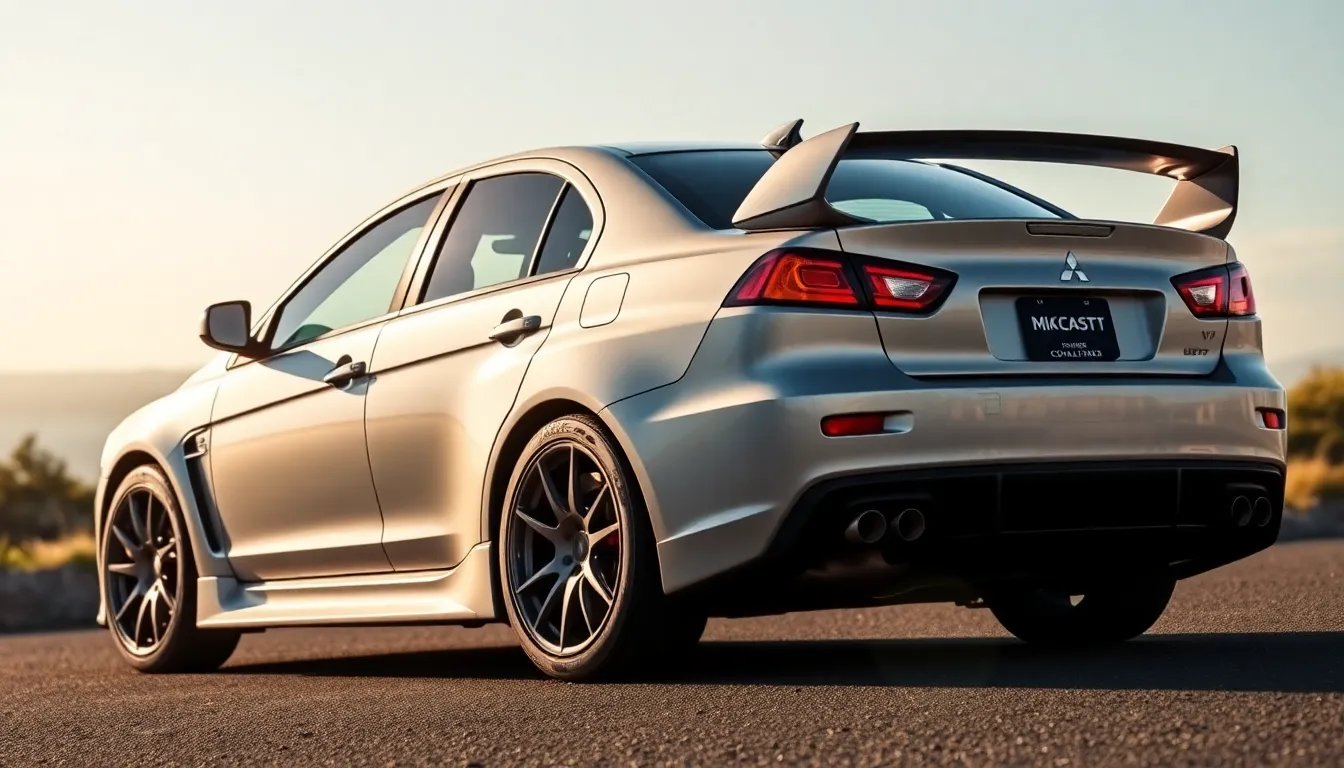
The Mitsubishi Lancer Evolution’s value proposition has transformed dramatically since production ended in 2016. Collectors and enthusiasts now view exact generations and trim levels as appreciating assets rather than mere performance vehicles.
Pricing Trends and Investment Potential
Evolution pricing patterns reveal important appreciation across multiple generations over the past seven years. Clean examples of the Evolution VI TME command premium prices ranging from $45,000 to $65,000, representing 300% to 400% increases from their original MSRP of approximately $15,000 in Japan. Evolution VIII and IX models show similarly impressive growth, with pristine examples selling between $35,000 and $55,000 depending on mileage and condition.
| Generation | Current Average Price | Original MSRP (US) | Appreciation Rate |
|---|---|---|---|
| Evolution VI TME | $55,000 | $15,000 (JDM) | 267% |
| Evolution VIII MR | $42,000 | $31,000 | 35% |
| Evolution IX MR | $48,000 | $33,000 | 45% |
| Evolution X Final Edition | $58,000 | $38,000 | 53% |
Low mileage examples with documented service histories achieve the highest values in today’s market. Evolution Final Edition models have emerged as particularly strong investments, with several examples exceeding $60,000 at auction even though their relatively recent production. Japanese domestic market versions typically command higher premiums due to their limited global availability and authentic specification packages.
Regional pricing variations affect Evolution values significantly across different markets. West Coast examples often carry 10% to 15% premiums over similar vehicles in other regions due to concentrated collector interest and stricter modification standards. Modified examples face value penalties unless modifications enhance rather than detract from the original engineering philosophy.
Finding and Buying a Used Evolution
Evolution purchasing requires careful evaluation of mechanical condition and maintenance documentation. Prospective buyers must inspect critical components including the turbocharger system, transmission, and all wheel drive components for signs of abuse or deferred maintenance. Service records provide the most reliable indicator of long term reliability, with oil change intervals and major service adherence directly correlating to engine longevity.
Import specialists offer access to exceptional Japanese domestic market examples that never reached US shores. These vehicles often feature lower mileage and superior preservation compared to domestic examples, though buyers must navigate complex import regulations and potential compliance modifications. Professional import companies typically charge $3,000 to $5,000 for complete import services including shipping and customs clearance.
Auction platforms including Bring a Trailer and Cars & Bids showcase premium Evolution examples regularly, with detailed documentation and professional photography that aids remote evaluation. Private party sales through enthusiast forums and social media groups often yield better values than dealer inventory, though these transactions require additional due diligence about vehicle history and condition verification.
Pre purchase inspections prove essential for Evolution acquisitions due to the complexity of their mechanical systems. Qualified technicians familiar with turbo all wheel drive systems can identify potential issues that may not manifest during brief test drives. Compression testing, boost leak detection, and transmission fluid analysis provide objective measures of mechanical health that justify their modest cost relative to potential repair expenses.
Conclusion
The Mitsubishi Lancer Evolution stands as one of the most important performance cars ever produced representing the perfect fusion of rally-bred engineering and street accessibility. We’ve witnessed how this remarkable machine transformed from a homologation special into a cultural icon that continues to influence automotive enthusiasts worldwide.
Today’s market clearly demonstrates the Evo’s enduring appeal with appreciating values and thriving aftermarket support ensuring its legacy remains strong. Whether you’re considering ownership or simply appreciate automotive excellence the Evolution’s impact on performance car development cannot be overstated.
We believe the Evo’s discontinuation marked the end of an era yet its influence lives on through dedicated communities passionate owners and the countless vehicles it inspired along the way.
Frequently Asked Questions
What is the Mitsubishi Lancer Evolution?
The Mitsubishi Lancer Evolution is a high-performance sports sedan that was produced from 1992 to 2016. Originally developed for rally racing to meet Group A regulations, it featured a turbocharged engine, advanced all-wheel drive system, and aerodynamic enhancements. The Evo became legendary for bridging the gap between motorsport competition and street performance across ten distinct generations.
How many generations of the Lancer Evolution were produced?
Mitsubishi produced ten generations of the Lancer Evolution over its 24-year production run from 1992 to 2016. Each generation introduced significant technological advancements and performance enhancements, with generations IV through VI marking the peak of rally success, and the final Evolution X ending production in 2016 with special limited-edition variants.
What engine powers the Lancer Evolution?
Most Lancer Evolution generations were powered by the legendary 4G63T turbocharged 2.0-liter four-cylinder engine, producing between 250-440 horsepower depending on the generation and variant. The final Evolution X introduced a new 4B11T engine. These engines featured advanced turbocharger technology and intercooler systems for consistent high-performance output.
What makes the Lancer Evolution’s all-wheel drive system special?
The Evolution featured sophisticated all-wheel drive systems including Active Yaw Control (AYC) and Super All-Wheel Control (S-AWC) technologies. These systems actively managed power distribution between wheels to optimize traction, handling, and cornering performance. The advanced mechanical differentials and electronic controls created exceptional grip and stability in various driving conditions.
Is the Mitsubishi Lancer Evolution a good investment?
Yes, the Lancer Evolution has become increasingly collectible since production ended in 2016. Many generations show significant appreciation from their original MSRP, with rare variants like the Evolution VI TME commanding premium prices. Market values continue rising due to limited production numbers (approximately 177,000 total units) and strong enthusiast demand.
How does the Evo compare to the Subaru WRX STI?
The Lancer Evolution and Subaru WRX STI were direct competitors with rally racing heritage. The Evo typically outperformed the STI in acceleration and track times, while both offered similar all-wheel drive performance capabilities. The Evolution was often praised for superior handling dynamics and more advanced differential technology compared to its Subaru rival.
What should I look for when buying a used Lancer Evolution?
When purchasing a used Evolution, prioritize mechanical condition and complete maintenance documentation. Have a pre-purchase inspection performed by a specialist familiar with the platform. Check for signs of modification, accident history, and ensure all recalls have been addressed. Original, unmodified examples with service records typically command higher values.
Does the Lancer Evolution have strong aftermarket support?
Yes, the Evolution platform enjoys extensive aftermarket support with numerous companies offering performance modifications. Owners can significantly increase power output through turbo upgrades, engine management, and supporting modifications. The strong aftermarket ensures parts availability and upgrade paths, making it popular among motorsports enthusiasts and tuners.







